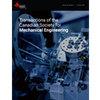Nozzle resonance mechanism and cooperative optimization of self-excited oscillating pulse cavitation jet
IF 1
4区 工程技术
Q4 ENGINEERING, MECHANICAL
Transactions of The Canadian Society for Mechanical Engineering
Pub Date : 2022-10-20
DOI:10.1139/tcsme-2021-0092
引用次数: 1
Abstract
The peak value and pulsation amplitude of the self-excited oscillating pulse cavitation jet nozzle are essential indices to evaluate the jet performance. We established a simulation model of the jet process of the nozzle to investigate the evolution mechanism of the inner and outer flow fields. We used the chamber fillet, chamber diameter, chamber length, and outlet-tube diameter as the design variables, and the peak value of the striking force and the amplitude of the pulsation of the striking force as the target variables. The collaborative optimization design method of the nozzle was determined by combining the orthogonal test method, the back propagation neural network, and the nondominated sorting genetic algorithm. As indicated by the results, when the inlet pressure was 3 MPa, the factors ranked as follows in terms of their effects on the jet performance of the nozzle: the chamber fillet, the outlet-tube diameter, chamber diameter, and the chamber length. To verify the feasibility of the collaborative optimization method, the nozzle was fabricated via 3D printing, and the simulation model was verified by testing. This study provides support to the development of design theory for self-oscillating pulsed cavitation jet nozzles.自激振荡脉冲空化射流喷嘴共振机理及协同优化
自激振荡脉冲空化射流喷嘴的峰值和脉动幅值是评价射流性能的重要指标。建立了喷嘴喷射过程的仿真模型,研究了喷嘴内外流场的演化机理。以腔体圆角、腔体直径、腔体长度和出口管径为设计变量,以冲击力峰值和冲击力脉动幅值为目标变量。结合正交试验法、反向传播神经网络和非支配排序遗传算法,确定了喷嘴协同优化设计方法。结果表明,当进口压力为3 MPa时,对喷嘴喷射性能影响最大的因素依次为:腔室圆角、出口管径、腔室直径和腔室长度。为了验证协同优化方法的可行性,采用3D打印技术制作了喷嘴,并通过测试验证了仿真模型。该研究为自振荡脉冲空化射流设计理论的发展提供了支持。
本文章由计算机程序翻译,如有差异,请以英文原文为准。
求助全文
约1分钟内获得全文
求助全文
来源期刊
CiteScore
2.30
自引率
0.00%
发文量
53
审稿时长
5 months
期刊介绍:
Published since 1972, Transactions of the Canadian Society for Mechanical Engineering is a quarterly journal that publishes comprehensive research articles and notes in the broad field of mechanical engineering. New advances in energy systems, biomechanics, engineering analysis and design, environmental engineering, materials technology, advanced manufacturing, mechatronics, MEMS, nanotechnology, thermo-fluids engineering, and transportation systems are featured.

 求助内容:
求助内容: 应助结果提醒方式:
应助结果提醒方式:


